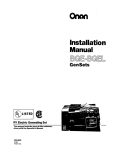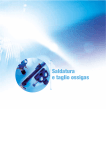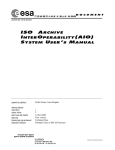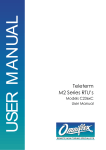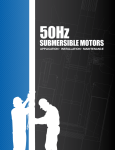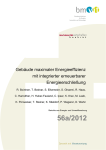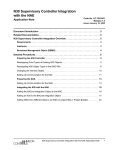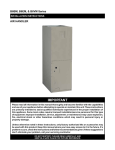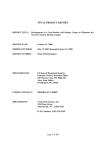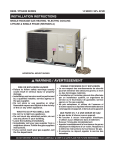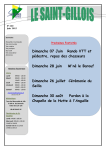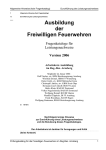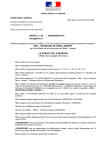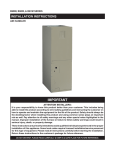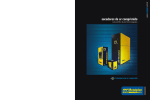Download Service Manual Service Manual
Transcript
$5.00 SUBMERSIBLE PUMPS 3ø Form No. GS3 © Copyright 1999 Goulds Pumps, ITT Industries Service Manual This manual covers three phase submersible pumps, motors and controls. Page Submersibles: Typical Systems . . . . . . . . . . . . . . . . . . . . . . . . . 4-7 Troubleshooting . . . . . . . . . . . . . . . . . . . . . . . . 8-13 Amprobe Instructions . . . . . . . . . . . . . . . . . . . 14 Ohmmeter Instructions . . . . . . . . . . . . . . . . . . 15 Megger. . . . . . . . . . . . . . . . . . . . . . . . . . . . . . 16 Insullation Resistance Ratings . . . . . . . . . . . . 17 A Wiring Diagrams . . . . . . . . . . . . . . . . . . . . 18-25 B Pump Control Panels. . . . . . . . . . . . . . . . . 26-31 B Fuse Test . . . . . . . . . . . . . . . . . . . . . . . . . . . . 32 B Coil Checkout . . . . . . . . . . . . . . . . . . . . . . . . . 33 B Contact Point Inspection . . . . . . . . . . . . . . 34-35 B Starter and Heater Sizing Checkout . . . . . . 36-39 C Voltage Checkout . . . . . . . . . . . . . . . . . . . 40-41 D Current Checkout . . . . . . . . . . . . . . . . . . . 42-43 E Motor Winding Resistance Checkout . . . . . 44-45 E Electric Short Checkout . . . . . . . . . . . . . . . 46-47 E Cable Checkout . . . . . . . . . . . . . . . . . . . . . 48-49 E Disassembly . . . . . . . . . . . . . . . . . . . . . . . 50-51 F Rotation. . . . . . . . . . . . . . . . . . . . . . . . . . . 52-53 G Unbalance . . . . . . . . . . . . . . . . . . . . . . . . . 54-55 G Transformer Sizes . . . . . . . . . . . . . . . . . . . 56-57 H Pressure Switch Checkout . . . . . . . . . . . . . . . 58 I Pressure Tank Checkout . . . . . . . . . . . . . . 60-61 J Submersible Motor Cooling . . . . . . . . . . . . 62-63 Cable Selection Charts . . . . . . . . . . . . . . . 64-66 TABLE OF CONTENTS Table of Contents TYPICAL SYSTEMS ! TYPICAL SYSTEMS Typical 3ø Submersible System ... WARNING! All electrical equipment must be connected to supply ground. Follow NEC and local code requirements. Multiple tank installation illustrated. RULE OF THUMB Pressure Tanks 1. High Capacity Subs (larger than 25 gpm) place check valve 1 pipe length above pump. 2. Always use a check valve for every 200 ft. of vertical pipe. Relief Valve Check Valve Starter Pump Check Valve Pressure Switch Pressure Gauge 4 NOTE: NOTE: Actual components and hook ups vary due to regional conditions, local codes and practices, and dealer preferences and practices. Manifold on multiple tank installation should be 1-1/2 to 2 times size of supply pipe from pump. 5 TYPICAL SYSTEMS Large capacity tank system illustrated with compressor. ! TYPICAL SYSTEMS Typical 3ø Submersible System... WARNING! All electrical equipment must be connected to supply ground. Follow NEC and local applicable code requirements. RULE OF THUMB Starter 1. Use same size or larger pipe as discharge on pump. 2. Always use a check valve for every 200 ft. of vertical pipe. Check Valve Pump Air Compressor Pressure Switch NOTE: Actual components and hook ups vary due to regional conditions, local codes and dealer preferences and practices. 6 7 TROUBLESHOOTING Troubleshooting INDEX Pump Will Not Start . . . The following pages (8 through 13) cover troubleshooting of submersible pumps. The use of an amprobe and ohmmeter are two essential items to properly check a system. Use of the amprobe is explained on page 14. Use of the ohmmeter is explained on page 15. Find the basic problem . . . for which numerous symptoms are listed and possible solutions are given for each: Page ■ Pump Will Not Start. . . . . . . . . . . . . . . . . . . . 9 ■ Pump Will Not Run . . . . . . . . . . . . . . . . . . . 10 ■ Pump Runs, But . . . . . . . . . . . . . . . . . . . . . 11 ■ Reduced Capacity or Insufficient Tank Pressure . . . . . . . . . . . . . . 12 ■ Pump Starts Too Frequently . . . . . . . . . . . . 13 TROUBLESHOOTING Troubleshooting If fuses and heaters check ok. . . PROBLEM: ANSWER: 1. No power or incorrect voltage For detailed checking procedure, see C pages 40, 41. 2. Defective pressure switch or control device Inspect switch and / or control – replace if necessary. 3. Defective or loose connection in starter, cable or motor For detailed checking procedure, see E pages 46-48. Condition causes improper resistance reading. 4. Magnetic starter malfunction For detailed checking procedure, see B pages 26-39. RULE OF THUMB Remember, there may be other system problems caused by auxiliary controls not covered in this booklet. ! IMPORTANT This manual is intended ONLY for use by Goulds Pumps, ITT Industries Dealers familiar with NEC (National Electrical Code) electrical codes and hydraulic and safety procedures of pump installations. 8 9 TROUBLESHOOTING Troubleshooting Pump Will Not Run ... Pump Runs, But... If motor overload trips or fuses blow. . . Little or no water delivered. . . PROBLEM: ANSWER: PROBLEM: ANSWER: 1. Improper size fuses, circuit breakers or heaters See checking procedure B pages 32-39. 1. Incorrect pump rotation See F pages 52, 53. 2. 2. Incorrect voltage See C pages 40, 41. Line check valve stuck or installed backwards Inspect and replace if necessary. 3. Phase loss or unbalance See G pages 54, 55. 3. Defective or loose connections in starter Inspect connections. 4. Incorrect starter size See B for sizing information pages 36-39. 4. Incorrect voltage See C pages 40, 41. 5. Pump not sufficiently submerged (air bound) Check water level in well. Defective or loose connections in starter, cable or motor See E pages 44-49. Condition causes improper resistance readings. 6. Leak in piping system Inspect and replace if necessary. 7. Suction screen or impellers clogged Pull pump and clean. 6. Defective pressure switch or control device Inspect switch and /or control - replace if necessary. 8. Broken pump shaft or coupling Pull pump and inspect. 7. Cable insulation, splice or motor defective See E pages 48, 49. Condition causes improper resistance readings. 9. Air trapped under check valve (air bound) Pump must be submerged a minimum of 10 '. 5. 8. Defective starter See B pages 36-39. 9. Pump bound by abrasives/debris Pull pump and clean. See D pages 42, 43. Condition causes high amperage. 10. Inadequate motor cooling 10 See J pages 62, 63. 10. Gases in well Start and stop pump several times. If this does not remedy conditions, well may contain too much gas for pump to operate properly. 11. Worn pump or motor Inspect and replace if necessary. 12. Incorrect pump See catalog performance data. 11 TROUBLESHOOTING Troubleshooting TROUBLESHOOTING Troubleshooting Reduced Capacity or Insufficient Pressure... Pump Starts Too Frequently... If motor overload trips or fuses blow. . . PROBLEM: PROBLEM: ANSWER: 1. Incorrect voltage See C pages 40, 41. 2. Incorrect pump rotation See F pages 52, 53. 3. Improper pressure switch setting See H pages 58. 4. Excessive pump wear Inspect and replace if necessary. 5. Leaks in piping system Inspect and replace if necessary. 6. Incorrect pump See catalog performance data. Franklin Electric Maximum Starts Per 24 Hour Day Maximum starts Per 24 Hr. Day Motor Ratings Single Phase Three Phase Up to 3⁄4 HP 300 300 1 HP - 5 HP 100 300 7 1⁄2 HP - 30 HP 50 100 40 HP and over 12 100 1. ANSWER: Waterlogged tank a. Standard galvanized Check tank for leaks. Check drain and “Y” fittings, snifter valve for proper operation. b. Pneumatic Check compressor and controller for proper operation. c. Pressurized type type See I pages 60, 61. 2. Check valve stuck open Inspect and replace if necessary. 3. Improper pressure switch setting See H pages 58. 4. Leaks in piping system Improper tank precharge Inspect and replace if necessary. Precharge tank at 2 lbs. less than pressure switch cut in. Must be sized to allow a minimum of run time per cycle. See rule of thumb below. 5. 6. Pressure tank improperly sized RULE OF THUMB For pumps 1.5 hp and smaller allow a minimum of one minute run time per cycle. For pumps 2 hp and larger allow a minimum of two minutes run time per cycle. (See table page 12) 13 TROUBLESHOOTING Troubleshooting AMPROBE INSTRUCTIONS Ohmmeter Instructions The Amprobe is a multi-range, combination ammeter and voltmeter. 1. Voltmeter Scales: 150 VOLTS 600 VOLTS 2. Ammeter Scales: 5 AMPS 15 AMPS 40 AMPS 100 AMPS 1. When used as an ammeter, the tongs are placed around the wire being measured with the rotary scale on the 100 amp range. Then rotate the scale back to the smaller ranges until an exact reading is indicated. 2. When used as a voltmeter, the two leads are clipped into the bottom of the instrument with the rotary scale on the 600 volt range. If the reading is less than 150 volts, rotate the scale to the 150 volt range to get a more exact reading. ! 14 WARNING! Checking has to be done with power on. The Ohmmeter is used for measuring the electrical resistance of a wire circuit. The unit of measurement is called an Ohm. 1. The knob at the bottom of the Ohmmeter is adjustable through six ranges: RX1 = R x 1 If your ohmmeter RX10 = R x 10 is digital readout RX100 = R x 100 type, refer to the RX1000 = R x 1,000 instructions that RX10K = R x 10,000 came with it. RX100K = R x 100,000 2. The round center knob is for the purpose of adjusting the instrument to zero (0) after clipping the two Ohmmeter leads together. This must be done every time the range selection is changed. ! WARNING! Use Ohmmeter only with power off. 15 OHMMETER INSTRUCTIONS Amprobe Instructions MEGGER Insulation Resistance Ratings Condition of Motor and Leads Ohm Value A new motor (without drop cable) 20,000,000 (or more) A used motor which can be reinstalled in the well 10,000,000 (or more) MOTOR IN WELL. Ohm readings are for drop cable plus motor This instrument is used to measure insulation resistance to ground. It consists of a crank-turned magneto, on the side of the case, and will give very close readings calibrated directly in ohms. It is cranked at a moderate rate of speed, approximately 120 rpm, until the pointer reaches a steady deflection. 1. If the ohm value is normal, the motor windings are not grounded and the cable insulation is not damaged. 2. If the ohm value is below normal, either the windings are grounded or the cable insullation is damaged. Check the cable at the well seal as the insullation is sometimes damaged by being pinched. 16 A new motor in the well 2,000,000 (or more) A motor in the well in reasonably good condition 500,000 2,000,000 A motor which has been damaged by lightening or with damaged leads. Do not pull the pump for this reason 20,000 5000,000 A motor which definately has been damaged or with damaged cable. The pump should be pulled and repairs made to the cable or the motor replaced. The motor will not fail for this reason alone, but it will probably not operate for long 10,000 20,000 A motor which has failed or with completely destroyed cable insulation. The pump must be pulled and the cable repaired or the motor replaced less than 10,000 17 INSULATION RESISTANCE RATINGS Megger... Wiring A Typical Diagrams Magnetic Starter & Pressure Switch To Fused Disconnect Or Circuit Breaker 3 To Fused Disconnect Or Circuit Breaker 3Ø 3 L1 L2 L3 1 L2 3 Phase Starter Furnas Magnetic Starter Furnas Magnetic Starter T1 T2 T3 Ground To Pump Motor Line Load Line Load A. WIRING DIAGRAMS A. WIRING DIAGRAMS Wiring A Typical Diagrams Line Load To Pump Motor Ground Pressure Switch Pressure Switch Reqires class 10 quick trip “k-heaters” (overloads), or adjustable class 10 overloads as in ESP100‘s NOTE: Check to be sure proper selection of pressure switch matched to system voltage has been made... refer to catalog data. Check that starter has ground. 18 RULE OF THUMB Check that starter has ground. 19 Typical Wiring Diagrams Magnetic Starter, Pressure Switch & B/W Liquid Level Control To Fused Disconnect Or Circuit Breaker 3 Input Power (As Required By Level Control) To Fused Disconnect Or Circuit Breaker 3Ø 3 L1 L2 L3 1 L2 Furnas Magnetic Starter 3 Phase Starter T1 T2 T3 Input Power (As Required By Level Control) Ground To Pump Motor 3 6 1 Line Load Line Load A. WIRING DIAGRAMS A A. WIRING DIAGRAMS A Typical Wiring Diagrams 2 Ground 9 Level Control 7 5 To Pump Motor Pressure Switch Lower Upper Electrode Line Load Ground Lower Upper Ground Electrode NOTE: Check to be sure proper selection of pressure switch matched to system voltage has been made... refer to catalog data. Check that starter has ground. 20 Furnas Magnetic Starter Pressure Switch 21 Wiring A Typical Diagrams Furnas Pumping Panel, Pressure Switch & B/W Liquid Level Control To Fused Disconnect Or Circuit Breaker 3Ø To Fused Disconnect Or Circuit Breaker 3 Furnas Pumping Panel 3 L1 L2 L3 1 L2 Input Power (Required By Level Control) Start 3 4 Hand/Off/Auto 3 Phase Starter 3 1 Input Power (As Required By Level Control) T1 T2 T3 4 2 To Pump Motor Ground 3 Start 6 1 Line Load Line Load A. WIRING DIAGRAMS A. WIRING DIAGRAMS A Typical Wiring Diagrams Ground Hand Lower Upper Off Electrode Auto 2 9 Level Control 7 5 Pressure Switch Lower Upper Ground Electrode To Pump Motor Furnas Pumping Panel Line Load Ground Pressure Switch NOTE: Check to be sure proper selection of pressure switch matched to system voltage has been made... refer to catalog data. 22 23 Subtrol & Pressure Switch To Fused Disconnect Or Circuit Breaker 3Ø Furnas Pumping Panel 3 L1 L2 L3 1 L2 3 To Fused Disconnect Or Circuit Breaker 3 Start Subtrol Panel 4 3 Phase Starter 3 1 T1 T2 T3 4 2 To Pump Motor Hand/Off/Auto Start Line Load Line Load A. WIRING DIAGRAMS A Typical Wiring Diagrams A. WIRING DIAGRAMS A Typical Wiring Diagrams Hand Off Auto Ground Line Load Ground To Pump Motor Pressure Switch NOTE: Check to be sure proper selection of pressure switch matched to system voltage has been made... refer to catalog data. 24 Pressure Switch 25 B. PUMP CONTROL PANELS B. PUMP CONTROL PANELS B Pump Control Panels 1 Combination Magnetic Starter (Furnas) 4 2 5 3 1. 2. 3. 4. 5. Disconnect switch. H-O-A switch. Start switch. Magnetic starter. Solid state motor protection device. The portion of the total cable, which is between the service entrance and a 3ø motor starter should not exceed 25% of the total maximum length of cable used to assure reliable starter operation. 26 27 B. PUMP CONTROL PANELS Pump ProtectionDevices Subtrol Plus Receiver B. PUMP CONTROL PANELS B 2 1 3 4 1. Subtrol Plus receiver programmed to match motor rating. 2. Control fuse block with fuse. 3. Class K-5 dual element type fuse clips with built-in fuse puller. 4. Subtrol sensor coils. 28 29 B. PUMP CONTROL PANELS 4 5 B. PUMP CONTROL PANELS B Pump Control Panels 6 AWA503 7 2 3 1 Duplex alternator panel may be used to alternate two submersible or centrifugal pumps. 1. Use one switch for a simple alternating system 2. Use two switches when the system is required to: A. Alternate two pumps B. Start the second pump in the event the first pump cannot meet the system demand. Auxiliary contacts allow the operation of one or two chemical feed pumps, such as chlorine or ozone injectors. 30 8 8 1. 2. 3. 4. 5. 6. 7. 8. NEMA 1 enclosure. Two hand-off auto switches. Two pump run lamps. Time delay. Alternator circuit. 120 VAC control circuit transformer. Relay. Terminals blocks for external wiring connections. 31 B. FUSE CHECKOUT Fuse Checkout... B Coil Checkout... ! 1. Set R x 1. 2. Connect leads as shown. 3. Reading: Should register zero. What It Means – Zero reading indicates fuse OK. Infinity ( ∞) reading indicates bad fuse. 32 B. COIL CHECKOUT B WARNING! Open master breaker and disconnect all leads from starter to avoid damage to meter or electric shock hazard. Connect the ohmmeter leads as shown above. Coil with Ohmmeter 1. Set R x 100. 2. Connect leads as shown. 3. Reading: Should register some value, Approx. 200-1000 ohms. What It Means – Infinity reading indicates coil is open. Zero reading indicates coil is shorted. In either case, the coil should be replaced. A reading of 200-1000 ohms indicates coil is ok. 33 B. CONTACT POINT INSPECTION B. CONTACT POINT INSPECTION Point B Contact Inspection... ! WARNING! Open (turn off) master breaker or disconnect all leads from starter (CB lid) to avoid damage to meter or electric shock hazard. 1. Remove contact point cover as shown. 2. Visually inspect all contact points. 3. Replace if necessary. What It Means – Burned, welded, or misaligned contacts may cause starter malfunction. What It Means – Burned, welded, or misaligned contacts may cause starter malfunction. 34 35 B. HEATER SIZING CHECKOUT ! Starter & Heater Sizing Checkout... WARNING! TURN POWER OFF! HP .5 .75 WARNING! Furnas Starter & Quick Trip Heater Selection... TABLE 1 1. Check for correct starter and heater size referring to starter and heater selection chart. 2. Double check to see that all three heaters are of the same size and installed properly and are tight. ! B TURN POWER ON! 1 3. Push the reset button; listen for click. 4. If overload was tripped, investigate the cause. What It Means – Improper starter and heater sizing provides inadequate overload protection that may lead to motor failure or nuisance tripping. 1.5 2 3 5 7.5 10 4" Three Phase Submersible Motors Volts Furnas Class 16 ESP 100 Starter Starter Starter Size Heaters Size No. 200 230 460 200 230 460 200 230 460 200 230 460 575 200 230 460 575 200 230 460 575 200 230 460 575 200 230 460 575 460 575 16AD 16AG 16AH 16AD 16AG 16AH 16AD 16AG 16AH 16AD 16AG 16AH 16AE 16AD 16AG 16AH 16AE 16AD 16AG 16AH 16AE 16AD 16AG 16AH 16AE 16CD 16BG 16AH 16AE 16AH 16AE K29 K28 K21 K34 K32 K23 K37 K34 K26 K42 K39 K29 K26 K50 K43 K33 K29 K55 K52 K37 K34 K62 K61 K49 K42 K70 K67 K55 K52 K61 K57 0 0 0 0 0 0 0 0 0 0 0 0 0 0 0 0 0 0 0 0 0 1 1 0 0 1 1 1 1 1 1 CSBD CSBA CSBC CSBD CSBA CSBC CSDD CSDA CSBC CSDD CSDA CSDC CSBE CSDD CSDA CSDC CSDE CSED CSEA CSDC CSDE DSFD DSFA CSDC CSDE DSFD DSFA DSEC DSEE DSEC DSEE Fuse Size Circ.bkr. Dual or std. Ele. 10 8 4 12 11 5 14 12 6 20 20 15 15 20 20 15 15 35 30 15 15 50 45 25 20 80 70 35 30 45 40 5 4 2 6 5 3 6 6 3 9 8 4 3 10 10 5 4 15 15 7 6 25 20 10 8 35 30 15 12 20 20 continued next page... 36 37 B. HEATER SIZING CHECKOUT B B. HEATER SIZING CHECKOUT HP 5 7.5 10 15 20 25 30 40 50 60 Volts 200 230 460 575 200 230 460 575 200 230 460 575 200 230 460 575 200 230 460 575 200 230 460 575 200 230 460 575 460 575 460 575 460 575 6" Three Phase Submersible Motors Furnas Class 16 ESP 100 Starter Starter Starter Size Heaters Size No. DD DG BH BE ED EG CH CE QD QG DH CE GD FG EH DE HD GG QH EE ID IG FH QE ID IG FH FE GH FE IH HE IH JE K61 K60 K49 K41 K68 K67 K55 K52 K72 K70 K58 K55 K76 K75 K64 K61 K78 K77 K70 K64 K86 K83 K72 K70 K88 K87 K74 K72 K77 K76 K83 K77 K87 K78 1 1 0 0 1 1 1 1 13⁄4 13⁄4 1 1 2 1⁄2 2 13⁄4 13⁄4 3 2 1⁄2 2 2 3 3 2 2 31⁄2 3 2 1⁄2 2 1⁄2 3 3 3 3 4 4 DSFD DSFG CSDH CSDE DSFD DSFG DSEH DSEE ESGD ESGG DSEH DSEE GSJD FSHG ESFH ESFE HSKD GSJG FSHH FSHE HSKD HSKG FSHH FSHE ISLD HSKG GSHH GSHE HSKH HSKE HSKH HSKE ISLH ISLE Fuse Size Circ.bkr. Dual or std. Ele. 50 45 25 20 70 70 30 25 100 80 40 35 150 125 60 50 200 175 80 70 225 200 100 80 300 250 125 100 150 125 200 150 250 200 25 20 10 8 30 30 15 12 40 35 20 15 60 60 30 25 60 70 35 30 100 90 45 35 125 110 50 40 70 70 90 70 100 80 TABLE 3 HP Volts 40 50 60 75 100 460 460 460 460 460 460 575 460 575 460 575 150* 175* 200* 8" Three Phase Submersible Motors Furnas Class 16 ESP 100 Starter Starter Starter Size Heaters Size No. GH IH IH IH JH I I I K77 K83 K86 K89 K93 K33 K28 K33 K31 K26 K32 3 3 3 1⁄2 3 1⁄2 4 HSKH HSKH ISLH ISLH JTMH N/A N/A N/A N/A N/A N/A Fuse Size Circ.bkr. Dual or std. Ele. 175 200 225 300 400 600 450 700 700 800 600 70 90 100 125 175 250 200 300 300 350 300 * Call Texas Turbine Division 806-743-5700 Ask for Technical Assistance. Note: FURNAS ESP100 starters with heaterless overloads include ambient compensated o/l and single phase protection. TOLL FREE ACTION NUMBER Answers to your installation questions on submersible pump motors are as close as your telephone... A Franklin submersible motor expert will handle your motor application inquires right away... and it’s toll free. Franklin Electric SERVICE HOTLINE 800-348-2420 (Also for Indiana) 38 39 B. HEATER SIZING CHECKOUT TABLE 2 C. VOLTAGE CHECKOUT 3ø STARTER C. VOLTAGE CHECKOUT 3ø STARTER C Voltage Checkout... 3ø Starter Checking Voltage at Fused Disconnect and Magnetic Starter VOLT 600 500 - ! 400 300 - WARNING! 200 100 0- Power is ON during voltage checking. 1. To check voltage: Use voltmeter on L1, L2 and L3 in sequence. Check should be made at four locations. Step 1 Checking incoming power supply. Step 2 Checking fuses. Step 3 Checking contact points Step 4 Checking heaters. 2. When checking voltage, all other major electrical appliances (that could be in use at the same time) should be running. 3. If incoming power supply readings are not within the limits (see chart), call your power supplier. VOLT 600 500 400 300 200 100 0- Voltage Limits Name Plate ▼ 208V 3ø 230V 3ø 460V 3ø 575V 3ø Measured Volts Min. Max. 188 228 207 253 414 506 518 632 NOTE: Phase to phase – full line voltage. Phase to neutral – 1⁄2 full line voltage. (depending on transformer connection) 40 RULE OF THUMB Incoming power should be within 5% of power supply voltage. Motors are rated ±10% of nameplate. The other 5% is used for cable voltage drop. 41 D. CURRENT CHECKOUT ! Current Checkout WARNING! Power is ON during voltage checking. TABLE 4 HP .5 .75 1 5 7.5 10 5 7.5 10 15 20 25 30 40 50 60 40 50 60 75 100 125 150 175 200 42 D. CURRENT CHECKOUT D Dia. 4" 4" 4" 4" 4" 4" 6" 6" 6" 6" 6" 6" 6" 6" 6" 6" 8" 8" 8" 8" 8" 8" 8" 8" 8" Three Phase Motors... Max. Amps Lbs. 200V 230V 460V 300 6.8 5.9 3.0 300 9.3 8.1 4.1 650 12.5 10.9 5.5 1500 20.5 17.8 8.9 1500 30.5 26.4 13.2 1500 – – 18.8 1,500 19.1 16.6 8.3 1,500 28.3 24.6 12.3 3,500 37.0 32.2 16.1 3,500 54.5 47.4 23.7 3,500 69.7 60.6 30.3 3,500 86.3 75.0 37.5 3,500 104.0 90.4 45.2 3,500 – – 62.0 3,500 – – 77.0 3,500 – – 91.0 10,000 – – 53.0 10,000 – – 65.0 10,000 – – 79.0 10,000 – – 97.0 10,000 – – 125.0 10,000 – – 165.0 10,000 – – 193.0 10,000 – – 218.0 10,000 – – 245.0 575V 2.4 3.2 4.4 7.1 10.6 15.0 6.6 9.8 12.9 19.0 24.4 30.0 36.2 49.6 61.6 72.8 42.0 53.0 61.0 78.0 104.0 136.0 154.0 174.0 196.0 Using Amprobe 1. Set scale to highest amp range. 2. Connect amprobe around lead as shown. 3. Rotate scale to proper range and read value. 4. Compare value with Table. What It Means – Currents above these values indicate system problems. 43 E. MOTOR WINDING RESISTANCE CHECKOUT 1. Set the scale lever to R x 1 for values under 10 ohms. For values over 10 ohms, set the scale lever to R x 10. Zero balance the ohmmeter as described earlier on page 15. ! WARNING! Open master breaker and disconnect all leads from starter to avoid damage to meter or electric shock hazard. Connect the ohmmeter leads as shown below. 2. Connect the ohmmeter leads as shown below. TABLE 5 Size Cable Cable Resistance — Copper Paired Wire Resistance (ohms per foot) 14 12 10 8 6 4 2 0 00 000 0000 If aluminum cable is used the readings will be higher. Divide the ohm readings on this chart by 0.61 to determine the actual resistance of aluminum cable. 44 .0050 .0032 .0020 .0013 .0008 .0005 .0003 .0002 .00015 .00013 .00010 TABLE 6 Motor Resistance 3ø Motors Resistance Motor Only (Ohms) – any 2 leads HP Dia. Lbs. 200V .5 .75 1.5 2.0 3.0 5.0 7.5 4" 4" 4" 4" 4" 4" 4" 900 900 900 900 900 900 900 5.0 7.5 10 15 20 25 30 40 50 60 6" 6" 6" 6" 6" 6" 6" 6" 6" 6" 1,500 1,500 3,500 3,500 3,500 3,500 3,500 3,500 3,500 3,500 .68-.84 .39-.48 .33.42 .22-.27 .14-.17 .11-.14 .10-.12 – – – 40 50 60 75 100 125 150 175 200 8" 8" 8" 8" 8" 8" 8" 8" 8" 10,000 10,000 10,000 10,000 10,000 10,000 10,000 10,000 10,000 – – – – – – – – – 230V 460V 575V 38.4-41.6 27.8-30.2 13.0-16.0 9.7-12.0 7.0-8.7 3.60-4.40 2.40-3.40 – – 20.3-25.0 15.1-18.7 10.9-13.6 5.60-6.90 – .88-1.09 .57-.71 .44-.55 .27-.33 .20-.25 .15-.19 .12-.15 – – – 3.53-4.37 2.17-2.68 1.76-2.17 1.07-1.32 .76-.94 .59-.73 .48-.60 .32-.40 .25-.32 .22-.27 – 3.65-4.41 2.87-3.47 1.70-2.10 1.22-1.52 1.01-1.25 .78-.95 .53-.59 .39-.48 – – – – – – – – – – .256-.283 .188-.207 .148-.163 .110-.121 .076-.084 .057-.063 .049-.054 .045-.050 .038-.042 – – – – – – – .067-.074 .060-.066 6.64-7.3 9.5-10.4 4.66-5.12 7.24-7.84 2.5-3.0 3.2-4.0 1.9-2.4 2.4-3.0 1.3-1.7 1.8-2.2 .70-.94 .93-1.20 .46-.57 .61-.77 What It Means – 1. If all ohm values are normal, the motor windings are neither shorted nor open. 2. If any one ohm value is less than normal, the motor is shorted. 3. If any one ohm value is greater than normal, the winding or the cable is open or there is a poor cable joint or connection. Ground Wire O H M S Winding Resistance Measuring ZERO OHMS RX100 RX10 RX1 RX1000 RX10K RX100K Motor Leads RX1 or RX10 When measured as shown on page 44, motor resistance only should fall within the values in Table 6. When measured through the drop cable, the size and length of the cable must be known and the correct cable resistance from Table 6 subtracted from the ohmmeter reading to get the winding resistance for comparison with Table 6. 45 E. MOTOR WINDING RESISTANCE CHECKOUT E Motor Winding Resistance Checkout... E. ELECTRICAL SHORT CHECKOUT Measuring Insulation Resistance 1. Set the scale lever to R x 100K (R x 100,000) and set the ohmmeter on zero. ! WARNING! Open (turn off) master breaker or disconnect all leads from starter (CB lid) to avoid damage to meter or electric shock hazard. 2. Connect an ohmmeter lead to any one of the motor leads and the other to the metal drop pipe. If the drop pipe is plastic, connect the ohmmeter lead to the metal well casing or ground wire. O H M S ZERO OHMS RX100 RX100K Drop Cable With Ground Wire 46 RX10 RX1 RX1000 RX10K RX100K Table 7 Normal Ohm and Megohm Values (Insulation Resistance) Between All Leads and Ground Insulation resistance does not vary with rating. All motors of all HP, voltage and phase rating have similar values of insulation resistance. Condition of Motor and Leads A new motor (without drop cable). A used motor which can be reinstalled in the well. Motor in Well. Ohm readings are for drop cable plus motor. A new motor in the well. A motor in the well in reasonably good condition. A motor which may have been damaged by lightning or with damaged leads. Do not pull the pump for this reason. A motor which definitely has been damaged or with damaged cable. The pump should be pulled and repairs made to the cable or the motor replaced. The motor will not fail for this reason alone, but it will probably not operate for long. A motor which has failed or with completely destroyed cable insulation. The pump must be pulled and the cable repaired or the motor replaced. Ohm Value Megohm Value 20,000,000 (or more) 10,000,000 (or more) 20.0 2,000,000 (or more) 500,000 2,000,000 20,000 500,000 10.0 2.0 0.5 - 2.0 0.02 - 0.5 10,000 20,000 0.01 - 0.02 less than 10,000 0 - 0.01 What It Means – 1. If the ohm value is normal, the motor windings are not grounded and the cable insulation is not damaged. 2. If the ohm value is below normal, either the windings are grounded or the cable insulation is damaged. Check the cable at the well seal as the insulation is sometimes damaged by being pinched. 47 E. ELECTRICAL SHORT CHECKOUT E Electrical Short Checkout ... E. CABLE CHECKOUT Cable Checkout... E. CABLE CHECKOUT E Checking Cable and Splice Test Checking Cable and Splice 1. Submerge cable and splice in steel barrel of water with both ends out of water. 2. Set ohmmeter selector on Rx100K and adjust needle to zero (0) by clipping ohmmeter leads together. 3. After adjusting ohmmeter, clip one ohmmeter lead to barrel and the other to each cable lead individually, as shown. 4. If the needle deflects toward zero (0) on any of the cable leads, pull the splice up out of the water. If the needle falls back to (∞) (no reading) the leak is in the splice. 5. If leak is not in the splice, pull the cable out of the water slowly until needle falls back (∞) (no reading). When the needle falls back, the leak is at that point. 6. If the cable or splice is bad, it should be repaired with waterproof electrical tape, or replaced. 48 OHMS Ohmmeter Set at RX 100K ZERO OHMS RX100 RX10 RX1 RX1000 RX10K RX 1 100K 0K Attach this Lead to Metal Tank 49 SUBMERSIBLES Some disassembly procedures differ between Series E and Series GS (newer). 1. Remove discharge head and casing. Remove 4 screws in cable guard, remove cable guard and set aside. On “GS” reinstall the two top screws. Remove the discharge head and casing as one assembly, the threads are left-hand. On “E” you can remove the discharge head and casing as one piece by reinstalling the two top screws or you can remove them as separate pieces. The “E” threads are right hand. PUMP DISASSEMBLY Pump Disassembly... 5. The complete stages consisting of bowl, impeller and diffuser, may be lifted off the shaft one at a time and the respective parts disassembled for inspection and/or renewal. 6. Remove nuts holding the motor adapter to the motor and remove the motor adapter. 7. Remove shaft sleeve. 8. Remove pump shaft and coupling assembly. Do not try to remove the coupling from the pump shaft. GS shown Note: to identify an “E” series model number look on the OD of bottom motor adapter flange 180° from cutout for motor leads. All pumps were stamped with water end model number, ex. 7EH05 or 18E15. To cross to “GS” simply replace the “E_ with GS, ex 7EH05 = 7GS05, 18E15 = 18GS15. GS: Left hand Thread. Series E: Right hand Thread. 2. Place the unit in a vertical position if you have a pump vise...otherwise lay pump on floor to loosen. 3. With two wrenches, one placed on the motor adapter and the other on the discharge head, unscrew the casting at the motor adapter. It should then lift off readily, exposing the stacked bowls. 4. Series E: If snap ring is provided on end of shaft, remove with snap ring pliers. If Klip Ring is provided, remove with screwdriver. Series GS: Remove Klip Ring with screwdriver. 50 On gaseous wells using “GS”. Rather than trying to remove the check valve we suggest you drill a 3/16" hole in it and install a line check one pipe joint above the pump. For other disassembly detail, see instruction manual. Series GS has built-in check valve. 51 F. ROTATION F. ROTATION F Rotation... Correct rotation is a must on all 3ø installations. Rotation can be checked by one of these three ways: VISUAL 1 1. Connect 3 motor leads to starter, run unit at open discharge. 2. Switch any 2 leads and again run unit at open discharge. 3. Largest quantity of water indicates correct rotation. VISUAL 2 1. Remove water end from meter. Run motor and observe rotation PRESSURE 1. Connect 3 motor leads to starter. Run unit against closed discharge, take maximum pressure reading. 2. Switch any 2 leads and again run unit against closed discharge. Take maximum pressure reading. 3. Highest pressure reading indicates correct rotation. ! WARNING! Prolonged reverse rotation operation can cause pump/motor damage. 52 53 G. UNBALANCE L1 Unbalance... L2 L1 Supply L3 Example: L2 L3 Starter T1 T2 Motor T3 Supply 1st Hookup 2nd Hookup 3rd Hookup L1 L1 L1 L2 L3 Starter T1 T2 L2 L3 Starter T3 T3 T1 L2 L3 Starter T2 T2 T3 T1 Motor T1T2 T3 For the best protection, we recommend no more than a 5% current deviation from average current. Current readings in amps should be checked on each leg using the three possible hookups. ! 54 CAUTION To prevent changing motor rotation, the motor leads should be reordered in the same direction, see example on page 51. Hook Up 1 T1 = 51 Amps T2 = 46 Amps T3 = 53 Amps Hook Up 2 T3 = 50 Amps T1 = 48 Amps T2 = 52 Amps Hook Up 3 T2 = 50 Amps T3 = 49 Amps T1 = 51 Amps Add up all three readings for hook up number 1. T1 = 51 Amps T2 = 46 Amps +T3 = 53 Amps Total 150 Amps Divide the total by three to obtain the average. 50 Amps = Average 3 150 Amps Calculate the greatest amp difference from the average. Could be greater than average. 50 Amps -46 Amps 4 Amps Divide this difference by the average to obtain the percentage of unbalance. .08 or 8% 50 4.00 Amps Hook Up #1 = 8% Hook Up #2 = 4% Hook Up #3 = 2% Always use hook up with lowest % current unbalance. Loads on a transformer bank vary. Readings should be taken at peak load period. RULE OF THUMB What It Means – If the unbalance moves with the motor leads the unbalance is caused by the motor, wet splice, or damaged cable. If the unbalance remains with the terminals the unbalance is in the power supply. 1. Hook ups below 5% = system balanced. 2. Hook ups not below 5% – if the unbalance moves with the motor leads the unbalance is caused by the motor, wet splice, or damaged cable. Check the motor on pages 44-45. If the unbalance remains with the terminals the unbalance is in the power supply – contact power company. 55 G. UNBALANCE G Calculate percentage of current unbalance for all three hookups. G. TRANSFORMER SIZES G. TRANSFORMER SIZES G Transformer Sizes... A full three phase supply is recommended for all three phase motors, consisting of three individual transformers or one three phase transformer. “Open” delta or wye connections using only two transformers can be used, but are more likely to cause problems from current unbalance. Transformer ratings should be no smaller than listed in the table for supply power to the motor alone. TABLE 8 Transformer Capacity Required for Submersible Motors Submersible 3ø Motor HP Rating Total 3ø Motor HP Rating 1.5 2 3 5 7.5 10 15 20 25 30 40 50 60 75 100 125 150 175 200 3 4 5 7.5 10 15 20 25 30 40 50 60 75 90 120 150 175 200 230 56 Smallest KVA Rating Each Transformer Open WYE or Delta 2 Transformers 2 2 3 5 7.5 10 15 15 20 25 30 35 40 50 65 85 100 115 130 Open Delta or Wye WYE Delta 3 Transformers 1 1.5 2 3 5 5 7.5 10 10 15 20 20 25 30 40 50 60 70 75 Full Three Phase 57 H. PRESSURE SWITCH ADJUSTMENT CHECKOUT Adjust in proper Sequence: 1. CUT-IN: Turn range nut down for higher cut-in pressure, or up for lower cut-in. 2. CUT-OUT: Turn differential nut down for higher cut-out pressure, or up for lower cut-out. FURNAS Note: Adjustment to range (cut-in) nut will also change cut-out pressure. ! CAUTION To avoid damage, do not exceed maximum allowable system pressure. Check switch operation after re-setting. RULE OF THUMB Check to be sure proper selection of pressure switch matched to system voltage has been made... refer to catalog data. 1. MAIN SPRING ADJUSTMENT: Turn clockwise to increase both Cut-Out and Cut-In pressure (2 psi / turn). 2. DIFFERENTIAL ADJUSTMENT: Turn differential nut clockwise to increase Cut-Out pressure without affecting Cut-In (3 psi / turn). ! CAUTION To avoid damage, do not exceed maximum allowable system pressure. Check switch operation after re-setting. SQUARE D 58 59 H. PRESSURE SWITCH ADJUSTMENT CHECKOUT H Pressure Switch Adjustment Checkout I. PRESSURE TANK CHECKOUT PROCEDURE To check: Shut off power supply and fully drain system to “0” pressure. There should be no water left in the tank(s). RULE OF THUMB Air pre-charge in top of pre-pressurized air tanks should be 2 psi less than the cut-in pressure of the pressure switch. Example: If pressure switch setting is 30-50 psi, tank should be pre-charged with 28 lbs. air when empty of all water and pump turned off. If water at air valve, replace tank. Pressure Switch Pressure Gauge In multiple tank installations, the pressure switch can be located between the start and toward the center of the piping manifold. The switch must be located no further away from the start of the piping manifold than the mid point. 60 61 I. PRESSURE TANK CHECKOUT PROCEDURE I Pressure Tank Checkout Procedure... J. SUBMERSIBLE MOTOR COOLING J J Submersible Motor Cooling J. SUBMERSIBLE MOTOR COOLING Submersible Motor Cooling A flow inducer sleeve should always be used when the pump is in a large body of water. Make sure that such an installation is grounded. When the pump is below any screen openings or below the bottom of the casing a top feeding well condition can exist which reduces the rate of cooling water flow past the motor. If the flow rate is less than specified a flow inducer sleeve is needed. Table 9 Required Cooling Flow Minimum GPM required for motor cooling in water up to 86°F (30°C). Inches casing or sleeve I.D. 4"high thrust motor .25 ft/sec GPM 4 1.2 — — 5 7 — — 6 13 9 — 7 20 25 — 10 62 6" motor .5 ft/sec GPM 8" motor .5 ft/sec GPM 8 30 45 10 50 90 55 12 80 140 110 14 110 200 170 16 150 280 245 A flow inducer sleeve is a tube over the motor, closed off above the pump intake and extended to the bottom of the motor or lower. The sleeve material is corrosion resistant metal or heavy plastic. 63 CABLE SELECTION CHARTS HP 1 ⁄2 3 ⁄4 1 1 1 /2 2 3 5 7 1⁄2 10 15 20 25 30 14 710 510 430 310 240 180 110* 0 0 0 0 0 0 12 1140 810 690 500 390 290 170 0 0 0 0 0 0 10 1800 1280 1080 790 610 470 280 200 0 0 0 0 0 AWG Copper Wire Size 8 6 4 3 2 2840 4420 2030 3160 1710 2670 4140 5140 1260 1960 3050 3780 970 1520 2360 2940 3610 740 1160 1810 2250 2760 440 690 1080 1350 1660 310 490 770 960 1180 230* 370 570 720 880 160* 250* 390 490 600 0 190* 300 380 460 0 0 240 300* 370* 0 0 0 250* 310* 1 4430 3390 2040 1450 1090 740 570 460 380* 00 0 5420 4130 2490 1770 1330 910 700 570 470 3050 2170 1640 1110 860 700 580 9170 7170 5470 3290 2340 1760 1200 930 750 620 8780 6690 4030 2870 2160 1470 1140 920 760 230V 60Hz Three Phase Three Wire ⁄2 ⁄4 1 930 1490 2350 3700 5760 8910 670 1080 1700 2580 4190 6490 8060 9860 560 910 1430 2260 3520 5460 6780 8290 1 1⁄2 6160 4770 3660 2190 1560 1170 800 610 500 410* 1 3 420 670 1060 1670 2610 4050 5030 2 320 510 810 1280 2010 3130 3890 3 240 390 620 990 1540 2400 2980 5 140* 230 370 590 920 1430 1790 7 1⁄2 0 160* 260 420 650 1020 1270 10 0 0 190* 310 490 760 950 15 0 0 0 210* 330 520 650 20 0 0 0 0 250* 400 500 25 0 0 0 0 0 320* 400 30 0 0 0 0 0 260* 330* 64 7530 5860 4480 2690 1920 1440 980 760 610 510 HP 1 ⁄2 3 ⁄4 1 1 1⁄2 2 3 5 7 1⁄2 10 15 20 25 30 40 50 60 75 100 125 150 175 200 14 3770 2730 2300 1700 1300 1000 590 420 310 0 0 0 0 0 0 0 0 0 0 0 0 0 12 6020 4350 3670 2710 2070 1600 950 680 500 340* 0 0 0 0 0 0 0 0 0 0 0 0 10 9460 6850 5770 4270 3270 2520 1500 1070 790 540 410* 0 0 0 0 0 0 0 0 0 0 0 AWG Copper Wire Size 8 6 4 3 2 9070 6730 5150 3970 2360 1690 1250 850 650 530* 430* 0 0 0 0 0 0 0 0 0 8050 6200 3700 2640 1960 1340 1030 830 680 500* 0 0 0 0 0 0 0 0 5750 4100 3050 2090 1610 1300 1070 790 640* 540* 0 0 0 0 0 0 5100 3800 2600 2000 1620 1330 980 800 670* 0 0 0 0 0 0 6260 4680 3200 2470 1990 1640 1210 980 830* 680* 0 0 0 0 0 1 0 00 7680 5750 3930 3040 2450 2030 1490 1210 1020 840* 620* 0 0 0 0 7050 4810 3730 3010 2490 1830 1480 1250 1030 760* 0 0 0 0 5900 4580 3700 3060 2250 1810 1540 1260 940* 740* 0 0 0 Lengths marked * meet the NEC ampacity only for individual conductor 60° C cable in free air or water, not in conduit. Flat molded cable is considered to be jacketed cable. This table is based on copper wire. 65 CABLE SELECTION CHARTS 460V 60Hz Three Phase Three Wire 200V 60Hz Three Phase Three Wire CABLE SELECTION CHARTS HP 1 ⁄2 3 ⁄4 1 1 1⁄2 2 3 5 7 1⁄2 10 15 20 25 30 40 50 60 75 100 125 150 175 200 14 5900 4270 3630 2620 2030 1580 920 660 490 330* 0 0 0 0 0 0 0 0 0 0 0 0 12 9410 6810 5800 4180 3250 2530 1480 1060 780 530 410* 0 0 0 0 0 0 0 0 0 0 0 10 9120 6580 5110 3980 2330 1680 1240 850 650 520* 430* 0 0 0 0 0 0 0 0 0 AWG Copper Wire Size 8 6 4 3 2 8060 6270 3680 2650 1950 1340 1030 830 680 500* 0 0 0 0 0 0 0 0 5750 4150 3060 2090 1610 1300 1070 790 640* 0 0 0 0 0 0 0 4770 3260 2520 2030 1670 1240 1000 850* 690* 0 0 0 0 0 5940 4060 3140 3860 2530 3110 2080 2560 1540 1900 1250 1540 1060 1300 860*1060* 0 790* 0 0 0 0 0 0 0 0 1 4760 3840 3160 2330 1890 1600 1310 970* 770* 0 0 0 0 5830 4710 3880 2860 2310 1960 1600 1190 950* 800* 0 0 NOTES NOTES 575V 60Hz Three Phase Three Wire 00 4770 3510 2840 2440 1970 1460 1160 990* 870* 0 Lengths marked * meet the NEC ampacity only for individual conductor 60° C cable in free air or water, not in conduit. Flat molded cable is considered to be jacketed cable. This table is based on copper wire. 66 67 68 NOTES NOTES NOTES NOTES 69 ADDRESSES & PHONE addresses & phone Company ______________________________________ Contact _______________________________________ Address _______________________________________ City __________________ State _______ Zip ________ Phone _________________ Fax ___________________ Company ______________________________________ Contact _______________________________________ Address _______________________________________ City __________________ State _______ Zip ________ Phone _________________ Fax ___________________ Company ______________________________________ Contact _______________________________________ Address _______________________________________ City __________________ State _______ Zip ________ Phone _________________ Fax ___________________ Company ______________________________________ Contact _______________________________________ Address _______________________________________ City __________________ State _______ Zip ________ Phone _________________ Fax ___________________ Company ______________________________________ Contact _______________________________________ Address _______________________________________ City __________________ State _______ Zip ________ Phone _________________ Fax ___________________ Company ______________________________________ Contact _______________________________________ Address _______________________________________ City __________________ State _______ Zip ________ Phone _________________ Fax ___________________ Company ______________________________________ Contact _______________________________________ Address _______________________________________ City __________________ State _______ Zip ________ Phone _________________ Fax ___________________ Company ______________________________________ Contact _______________________________________ Address _______________________________________ City __________________ State _______ Zip ________ Phone _________________ Fax ___________________ Company ______________________________________ Contact _______________________________________ Address _______________________________________ City __________________ State _______ Zip ________ Phone _________________ Fax ___________________ Company ______________________________________ Contact _______________________________________ Address _______________________________________ City __________________ State _______ Zip ________ Phone _________________ Fax ___________________ Company ______________________________________ Contact _______________________________________ Address _______________________________________ City __________________ State _______ Zip ________ Phone _________________ Fax ___________________ Company ______________________________________ Contact _______________________________________ Address _______________________________________ City __________________ State _______ Zip ________ Phone _________________ Fax ___________________ 70 71 ADDRESSES & PHONE addresses & phone $5.00 SUBMERSIBLE PUMPS 3ø Form No. GS3 © Copyright 1999 Goulds Pumps, ITT Industries Service Manual





































